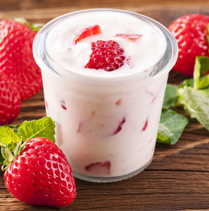
Hear what nutrition expert Jo Ann Tatum Hattner, MPH, RD has to say about including probiotics in your child’s diet.
Based on her pediatric practice and current research from her book Gut Insight, you’ll learn just how easy it is for your children to reap the health benefits for their growing immune systems.
What should parents know about probiotics and their health benefits for children?
I like to think of probiotics as our guts’ good friends. Adding foods and drinks with probiotics to your family’s diet will provide numerous benefits for all ages, and particularly for children. In my book Gut Insight I explain the science supporting the use of probiotics in easy-to-understand terms. Some of the best studies supporting benefits of probiotics have been reported in the pediatric scientific literature. These include:
- Enhanced immunity— the gut is your immune command center, overseeing regulation of immune responses including inflammation. Probiotics have been shown to boost immune function.
- Reduction of disease–causing bacteria — when beneficial probiotics populate your gut, the majority rules and unhealthy bacteria become the minority.
- Prevention of allergy — the allergic response may be related to an excessive or imbalanced immune response; probiotics are used for the prevention and reduction of allergic symptoms.
- Treatment of antibiotic-associated diarrhea — caused by the use of broad-spectrum antibiotics, the associated diarrhea can be reduced by the use of probiotics.
There are a number of yogurt brands on the market right now. What are the most important things to look for when shopping for yogurts or other probiotic foods?
In the marketplace today there are numerous yogurt products and it does take knowledge to sort them out. In my book, Gut Insight, I discuss that yogurt is a fermented food, fermented with live bacterial cultures. Here are some guidelines to help you when searching for the right yogurt for you and your family.
First, look for “live active cultures” on the label but then have a discerning eye for the actual cultures which may be listed in the ingredients or shown separately on the carton. The two traditional yogurt cultures used for fermentation are strains of S. Thermophilus and L. Bulgaricus. Some yogurts only contain these bacteria.
Second, look for the probiotics, ideally with the strain listed. This is not easy to find as most often just the genus and the species is listed. For example if all three are listed it will read L. casei DN-114001. In other products, for example, the drinkable dairy based products, you can often find the three names, with the genus, the species and the strain listed, for example, as Lactobacillus casei Shirota or L. casei DN-114001.
Finally, look for the manufacturer’s contact information so you can get in touch with them for more information if needed.
I do often tell parents that if the product is from a reputable company that you trust you may have to just try it and evaluate the results. I advise a two-week trial for a fair evaluation.
Are there any added benefits to consuming probiotics through foods, rather than taking them in a pill form?
Yes, foods contain nutrients, so, in addition to the live active probiotic cultures, you are getting important nutrients. For example, with just a 4oz serving of yogurt, you benefit from:
- protein, which provides indispensable amino acids to build lean body mass in growing children
- calcium, which is important for forming the structure of teeth and bones
- riboflavin, a B vitamin important for energy production.
In addition, establishing a taste for yogurt in the early years means it will likely continue as a favorite food. Supplements can be used for specific needs, whereas establishing a food habit is valuable for lifelong health.
What are some yummy ways to incorporate yogurt into a breakfast, lunch, or dinner for the family?
I suggest that yogurt be offered to children at the morning meal or for snacks along with honey and bite-sized, ripe fruit as a topping. Seasonal fruits – kiwi, berries, apricots, and figs – are delicious with yogurt and honey.
Do you have any tips for getting children to eat unsweetened yogurt?
Begin feeding plain yogurt at about nine months. Most infants will accept it plain. If needed, add a pureed ripe fruit which you can stir into the plain yogurt. Once kids have tasted commercially fruited sweetened yogurt it is difficult to get them to accept plain again. I suggest in the toddler years to use the fruits and even a jelly or jam to sweeten the plain yogurt.
A simple favorite recipe for older kids is “Yogurt Ranch Dressing” for a vegetable dip or over small Bibb lettuce wedges.
| Ranch Dressing Recipe |
Combine all ingredients with a whisk and store in glass jar in the refrigerator. |
Lately, there has been increased media focus on prebiotics, which sounds pretty similar to probiotics. What should parents know about prebiotics?
Prebiotics are the “cuisine” of the probiotics, as bacteria have to eat too. The nondigestible fibers known as prebiotics are found in many natural plant foods. They are fermented by the probiotics in the lower part of the gut. This process provides nourishment to the beneficial probiotics so they can thrive and function, adding beneficial by-products of fermentation, which protect the colon.
The natural foods that contain prebiotics surround you. Some are probably common to your kitchen – bananas, onions, garlic, shallots, leeks, whole wheat and barley. In Gut Insight there is a listing of foods with resources on where to find them and numerous suggestions for incorporating these plant foods into your family’s diet.
Do you have any easy recipes that you use to incorporate prebiotic foods into your diet?
Yes, artichokes are a prebiotic food. Once kids are familiar with artichokes they like them in many forms. I like to prepare the whole artichoke and then let the kids pick off the leaves to dip either in the Ranch Dressing (the recipe is above) or another type of dip, for example, hummus or bean dip.
Because artichokes can be intimidating the first time you try to cook and eat them, you may need help. In Gut Insight you will find links to videos which teach you how to prepare and eat artichokes, as well as recipes from one of the largest California producers of artichokes www.oceanmist.com.
| Steamed Artichokes Recipe |
|
Are probiotics available only in dairy products?
No; other choices – for example, soy yogurt and smoothies for those who prefer soy over dairy – are available; a listing is included in Gut Insight. As the benefits of probiotics have become better known, products fortified with them are proliferating – including soy products, cereals, energy bars and drinks. Again, check labels to make sure active live cultures are included.
Does mother’s milk contain prebiotics?
Yes; breast milk contains some bacteria, as it is not a sterile feeding, along with prebiotic carbohydrates, which fuel beneficial bacterial growth. In Gut Insight you can read more about probiotics and prebiotics through the various life stages.
What do you think surprises your readers the most when they learn about this topic?
I think many people are just in awe, as I was, that the gut has such an important function and that the immune response can occur in the gut. So many harmful pathogens can enter the body through the mouth and digestive system. Readers have a new respect after reading the book. Many have told me that they had no idea how important digestive health was. Many people have also started to contact me to find out how to make their own yogurt!
When parents are looking for yogurt, would you agree that it’s best to choose yogurt that is rGBH free – organic?
Organic is a personal choice. It means the yogurt is made with organic milk and the cows were not treated with bovine growth hormone.
Are the health benefits of prebiotics very different from probiotics, or do they serve more to enhance these benefits?
It’s really the probiotic that has the health benefits. These have been clinically studied. The prebiotics are undigestible carbohydrate fibers that are used by probiotics and fermented in the colon. The byproducts of fermentation are being studied for colon health. It may well be that they promote a healthier colon, while supporting the growth of probiotics.
How did you get interested in pre/probiotics as a topic?
I worked in pediatric gastroenterology at Stanford, and I was using yogurt as a food to re-feed kids with damage to their intestinal tract. Over time, I just got more interested and while working with an advisory group, realized that there was so much going on in probiotics. Probiotics have been used in Europe and Asia for a long time, but the use of live active cultures is just recently been promoted in the United States.
Marketing of products has resulted in heightened consumer interest. Consumers have heard and read that you can enhance immunity, establish regularity, and use probiotics to treat antibiotic diarrhea, and, in turn, they have become more knowledgeable and are looking for health solutions on their own. I wrote the book because I thought of the consumer standing in front of the dairy case trying to figure it all out. And although this book was written for the consumer, is has also turned out to be a great resource for medical professionals as well.
Jo Ann Tatum Hattner, MPH RD, author of Gut Insight: probiotics and prebiotics for digestive health and well-being, has over thirty years experience practicing nutrition in the San Francisco Bay area, primarily at Stanford Medical Center where she specialized in pediatric nutrition. She teaches medical students nutrition at Stanford University School of Medicine. She is a frequent speaker at national professional meetings of dietitians, physicians, nurses and other professionals and served for over ten years as a spokesperson for the American Dietetic Association. Visit her website at: www.gutinsight.com for further information.
You can view all of our expert interviews Here.












